Published
on 1
May 2007
|
All rights reserved.
|
|
|
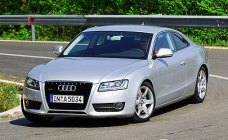 Audi
is enjoying rapid growth in recent years. Last year, it sold a record
905,000 cars worldwide, or 9 percent more than a year ago.
Nevertheless, the management at Ingolstadt is not content. It plans to
increase sales to 1.5 million cars by 2015. To meet that target, it
will introduce more models and broaden its range to cover more market
segments. A couple of years ago, we already saw the addition of Q7
luxury SUV. Last year we had R8 sports car. This year the focus will be
on the new A5 coupe. Besides, A1, A7, Q3 and Q5 are also on the
pipeline. It is hard to imagine that, just a dozen years ago Audi's
model range consisted of only A4, A6 and A8. Audi
is enjoying rapid growth in recent years. Last year, it sold a record
905,000 cars worldwide, or 9 percent more than a year ago.
Nevertheless, the management at Ingolstadt is not content. It plans to
increase sales to 1.5 million cars by 2015. To meet that target, it
will introduce more models and broaden its range to cover more market
segments. A couple of years ago, we already saw the addition of Q7
luxury SUV. Last year we had R8 sports car. This year the focus will be
on the new A5 coupe. Besides, A1, A7, Q3 and Q5 are also on the
pipeline. It is hard to imagine that, just a dozen years ago Audi's
model range consisted of only A4, A6 and A8.
How to describe the A5 ? slotting between A4 and A6, it would be safe
to assume that it is sized and priced in the middle. However, the truth
is not as simple. Regarding price, yes, it will be more expensive than
A4 and cheaper than A6. But in terms of size it is basically the coupe
version of the next generation A4. In other words, A5 is the direct
competitor of BMW 3-Series Coupe. Ridiculously, Audi adopted a
nomenclature policy given up by BMW – the latter once planned to name
the current 3-Series Coupe as the 4-Series. Using a larger number could
help raising the perceived market positioning and misleading its
customers to pay more money. A clever trick.
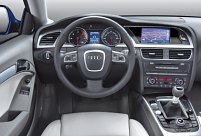 Of
course, if a coupe want to ask for higher price, it has to look more
beautiful than the equivalent sedan. Audi and Volkswagen group design
chief Walter de'Sliva said "The A5 is the most beautiful car I have
ever designed". Sure, the A5 has some great details, such as the
flowing crest line over the shoulders. But to describe it a more
beautiful design than his Alfa Romeo 156 and Seat Altea / Leon might be
too exaggerated. No matter from photographs or from the comments of
other automotive designers, the A5 cannot be described as a
masterpiece. It is still more Germanic ice cool than Italian sexy, more
about fine detailing than imaginative shape. Of
course, if a coupe want to ask for higher price, it has to look more
beautiful than the equivalent sedan. Audi and Volkswagen group design
chief Walter de'Sliva said "The A5 is the most beautiful car I have
ever designed". Sure, the A5 has some great details, such as the
flowing crest line over the shoulders. But to describe it a more
beautiful design than his Alfa Romeo 156 and Seat Altea / Leon might be
too exaggerated. No matter from photographs or from the comments of
other automotive designers, the A5 cannot be described as a
masterpiece. It is still more Germanic ice cool than Italian sexy, more
about fine detailing than imaginative shape.
However, the interior is undeniably very stylish and desirable,
although we have already seen similar designs in other Audis. As you
would expect, the materials and build quality beats BMW 3-Series Coupe
and Mercedes CLK easily. But the cabin is not as bright and airy as its
rivals, blame to the thick pillars and high waistline, a common problem
for most Audis. While the front seats are accommodative, the rear seats
are very small. They are seriously short of head and legroom thus are
only suitable for children or short adults. This is probably the
biggest weakness of the A5, because 3-Series Coupe and CLK are genuine
4-seater. Strangely, the A5 runs a generous 2751mm wheelbase, so where
is the legroom gone ? its exterior doesn't look as sleek as Peugeot 407
Coupe, so where is the rear headroom lost ? Walter de'Silva owes us a
satisfactory answer. He should know that a good design must combine
forms and functions, while a bad design fails to excel in forms and
functions simultaneously...
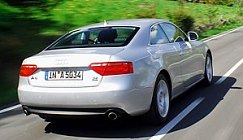 Anyway,
the most significant thing to me is not the styling or the packaging,
but the new platform that A5 introduces. Called MLB platform (Modularer
Längsbaukasten, or modular length components), it will be used by
the next generation A4, A6, A7 as well as Q5, virtually the majority of
Audi's production cars. The MLB not only employs new 5-link front
suspensions and updated trapezoidal multi-link rear suspensions, but
the most important is that it is engineered to cure the nose-heaviness
traditionally associated with Audi. Until now, all Audis with
longitudinal engines have both their engine and clutch located in
front of the front differential and axle. In the MLB, the front
differential and axle locate between the engine and the clutch. This
pushes the front axle forward by 12cm, reducing the weight over
the nose and lengthening the wheelbase. To save further weight from the
front half of the chassis, the A5 employs aluminum front fenders (so
why not also aluminum bonnet ? I wonder).
Another improvement is the steering rack, which is now mounted lower
and closer to the wheel axis for improved feel and response. Moreover,
the Quattro system has 40/60 torque split between front and rear axle
to reduce understeer. If everything go as well as Ingolstadt claimed,
the A5 might open a new era for dynamically exciting Audis... Anyway,
the most significant thing to me is not the styling or the packaging,
but the new platform that A5 introduces. Called MLB platform (Modularer
Längsbaukasten, or modular length components), it will be used by
the next generation A4, A6, A7 as well as Q5, virtually the majority of
Audi's production cars. The MLB not only employs new 5-link front
suspensions and updated trapezoidal multi-link rear suspensions, but
the most important is that it is engineered to cure the nose-heaviness
traditionally associated with Audi. Until now, all Audis with
longitudinal engines have both their engine and clutch located in
front of the front differential and axle. In the MLB, the front
differential and axle locate between the engine and the clutch. This
pushes the front axle forward by 12cm, reducing the weight over
the nose and lengthening the wheelbase. To save further weight from the
front half of the chassis, the A5 employs aluminum front fenders (so
why not also aluminum bonnet ? I wonder).
Another improvement is the steering rack, which is now mounted lower
and closer to the wheel axis for improved feel and response. Moreover,
the Quattro system has 40/60 torque split between front and rear axle
to reduce understeer. If everything go as well as Ingolstadt claimed,
the A5 might open a new era for dynamically exciting Audis...
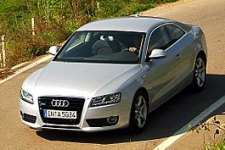 A5 offers 4 competitive engines
for its customers to choose from: 170hp 1.8 TFSI (a smaller brother of
the excellent 2.0 TFSI), 265hp 3.2 FSI V6 with new Valvelift
system,
190hp 2.7TDI V6 turbo diesel and 240hp 3.0TDI V6 turbo diesel. They
mate with either 6-speed manual gearbox or the excellent Multitronic
CVT, whose manual mode now offers 8 speeds. All engines are competitive
against BMW 3-Series Coupe, especially the 1.8 TFSI. The Valvelift 3.2
V6 is also a willing engine, if not as strong as the super-torquey
3.0TDI. The latter produces 369 lbft of torque from 1500-3000 rpm,
enabling the A5 to sprint from zero to 60 mph in only 5.7 seconds with
the help of Quattro traction. Most people regard the 3.0TDI as the best
engine of the range. However, one should note that it is not as smooth
and quiet as 330d or CLK320CDI. Besides, its extra weight means the car
is less keen to change direction than the lighter petrol V6. A5 offers 4 competitive engines
for its customers to choose from: 170hp 1.8 TFSI (a smaller brother of
the excellent 2.0 TFSI), 265hp 3.2 FSI V6 with new Valvelift
system,
190hp 2.7TDI V6 turbo diesel and 240hp 3.0TDI V6 turbo diesel. They
mate with either 6-speed manual gearbox or the excellent Multitronic
CVT, whose manual mode now offers 8 speeds. All engines are competitive
against BMW 3-Series Coupe, especially the 1.8 TFSI. The Valvelift 3.2
V6 is also a willing engine, if not as strong as the super-torquey
3.0TDI. The latter produces 369 lbft of torque from 1500-3000 rpm,
enabling the A5 to sprint from zero to 60 mph in only 5.7 seconds with
the help of Quattro traction. Most people regard the 3.0TDI as the best
engine of the range. However, one should note that it is not as smooth
and quiet as 330d or CLK320CDI. Besides, its extra weight means the car
is less keen to change direction than the lighter petrol V6.
In
terms of engines and performance, A5 runs neck to neck with BMW
3-Series Coupe. But what about chassis dynamics ? Disappointingly,
despite of all the claimed improvement to drivetrain layout, steering
and Quattro system, A5 still rides and handles like old-school Audis.
While there is plenty of grip and little body roll, the chassis
continues to feel heavy at its nose. It does not steer as keenly as the
BMW. It runs into terminal understeer at tight corners. It does not
offer any throttle adjustability, so the driving experience is
uninspiring. The ride quality is also poor. Its suspension is stiff and
only rides comfortably over the smoothest surfaces. Again, this is an
Audi designed for Autobahn while ignoring all other countries.
Since RS4, Audi has made a lot of improvement on dynamics, especially
in the recent TT and R8. Just when we expect to see another forward
leap, A5 actually winds back. We cannot understand how it could wasted
such good materials and resulted in packaging, handling and ride so
poor. Now the guys at Munich must be laughing.
|
Verdict:    |
| Published
on 1
May 2007 |
All rights reserved.
|
|
S5
|
|
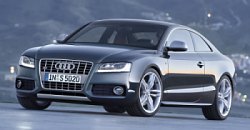 Before
the arrival of RS5, S5 is the highest performance model of the A5
range. Compare with its lesser brothers, it has stiffer and lower
suspensions, a front suspension tower bar for reinforcing chassis,
18-inch 245/40 tires (optional 255/35ZR19), larger brakes and, of
course, a more potent 4.2-liter V8. The same 40/60 Quattro system is
compulsory in this model, so is a 6-speed manual gearbox (although
dual-clutch gearbox is expected later). Outside, the biggest
differences are the more aggressive front bumper, skirts and a
single-frame radiator grille added with vertical chromed bars. Before
the arrival of RS5, S5 is the highest performance model of the A5
range. Compare with its lesser brothers, it has stiffer and lower
suspensions, a front suspension tower bar for reinforcing chassis,
18-inch 245/40 tires (optional 255/35ZR19), larger brakes and, of
course, a more potent 4.2-liter V8. The same 40/60 Quattro system is
compulsory in this model, so is a 6-speed manual gearbox (although
dual-clutch gearbox is expected later). Outside, the biggest
differences are the more aggressive front bumper, skirts and a
single-frame radiator grille added with vertical chromed bars.
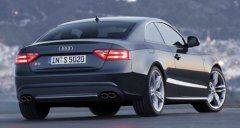 Undoubtedly, the V8
engine is the focus of the car. Transplanted from S4, it has all the
technologies a high-performance engine needed - all-alloy construction,
DOHC 32 valves, FSI direct injection, dual continuous variable valve
timing and a two-stage variable intake manifolds made of magnesium. The
result is 354 horsepower at 7000 rpm and 324 lbft of torque at 3500
rpm. This engine is rev-happy yet offers plenty of low down torque. For
example, 85 percent of the maximum torque is available from 2000 rpm.
This allows remarkable in-gear acceleration, saving the need to touch
the notchy 6-speed gearbox too often. In addition to the excellent
traction offered by Quattro, the S5 accelerates from 0 to 60 mph in
only 4.9 seconds, some 0.3 second faster than the twin-turbo BMW 335Ci,
its closest rival. Undoubtedly, the V8
engine is the focus of the car. Transplanted from S4, it has all the
technologies a high-performance engine needed - all-alloy construction,
DOHC 32 valves, FSI direct injection, dual continuous variable valve
timing and a two-stage variable intake manifolds made of magnesium. The
result is 354 horsepower at 7000 rpm and 324 lbft of torque at 3500
rpm. This engine is rev-happy yet offers plenty of low down torque. For
example, 85 percent of the maximum torque is available from 2000 rpm.
This allows remarkable in-gear acceleration, saving the need to touch
the notchy 6-speed gearbox too often. In addition to the excellent
traction offered by Quattro, the S5 accelerates from 0 to 60 mph in
only 4.9 seconds, some 0.3 second faster than the twin-turbo BMW 335Ci,
its closest rival.
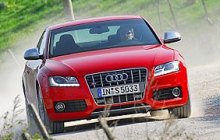 Not so good is the
chassis dynamics. Given the more sporting pretension of S5, the result
is even more disappointing than the rest of the A5 range. Its harder
suspensions make the ride even harsher around town or on back roads.
Its bigger engine makes the car even more nose-heavy. It feels big and
unwieldy in twisty roads. Although the 4-wheel-drive and grippy tires
offer a secured handling, it just fails to turn into corners as eager
as a sports coupe should. The steering might be quick and precise, but
it is too light and lack of feedback. Apart from the engine and
performance, this car is shamed to wear the S-badge. Not so good is the
chassis dynamics. Given the more sporting pretension of S5, the result
is even more disappointing than the rest of the A5 range. Its harder
suspensions make the ride even harsher around town or on back roads.
Its bigger engine makes the car even more nose-heavy. It feels big and
unwieldy in twisty roads. Although the 4-wheel-drive and grippy tires
offer a secured handling, it just fails to turn into corners as eager
as a sports coupe should. The steering might be quick and precise, but
it is too light and lack of feedback. Apart from the engine and
performance, this car is shamed to wear the S-badge.
Overall, the S5 is a fast but unexciting drive. Although it is faster
than BMW 335Ci, the latter is a far superior driver's car. The BMW is
also much more rounder, with excellent ride, good rear seat space and
far better fuel consumption (29.7mpg vs 22.7mpg combined). Moreover,
there is a huge price difference between the two cars - £40,000
for S5 and £34,000 for 335Ci. Apparently, the Audi is seriously
overpriced. Our choice cannot be any clearer.
|
Verdict:    |
Published
on 26
Jul 2009
|
All rights reserved.
|
|
A5 Sportback
|
|
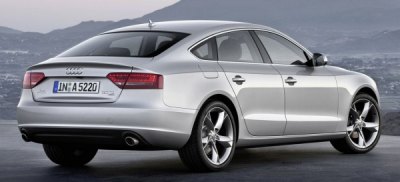
|
Sportback sits something between A5
coupe and A4 sedan...
|
The
borderline between sedans and coupes get mushy with cars like Mercedes
CLS and Volkswagen Passat CC. Audi joins the new segment with A5
Sportback. Based on the A5 coupe, with its wheelbase stretched for 60
mm to accommodate a pair of full-size rear seats, adding rear doors to
ease rear passenger access and a large hatchback door to make loading
cargo easier, the A5 Sportback sits something between A5 coupe and A4
sedan. Compare with the latter, it is slightly wider and lower,
implying a sportier handling. The sleeker look, with a swoopy roof line
and flowing waistline, is more attractive than the sedan - and the
coupe as well, I would say.
Digging out the difference among A4, A5 and A5 Sportback has little
meaning, because all of them are based on the same underpinnings. As a
result, the Sportback shares its siblings' 40:60 Quattro system,
7-speed S-Tronic box, electronic adaptive damping, Dynamic Steering
(i.e. active steering), Audi Drive Select (i.e. comfort/sport mode
control) and a range of advanced engines. Our pick of the range is not
the range-topping 265hp 3.2 Valvelift V6, but the cheaper and far more
frugal 2.0 TFSI Valvelift four-pot which produces enough power (211hp
and 258 lb-ft) to do 0-60 mph in 6.3 seconds when coupling to Quattro
traction. In the diesel side, the excellent 240hp 3.0TDI V6 is
definitely the choice.
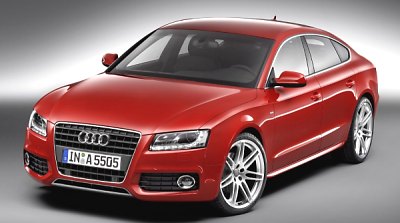
|
Nice car arrived at the wrong timing...
|
As
expected, the Sportback does not
alter the driving dynamics of its siblings. It is competent but not as
interesting to drive as BMW 3-Series or Mercedes C-class. Like A5
Coupe, the ride is too stiff on S-Line suspension, or too civilized on
the standard setup.
The interior shares the same genes with A5. The driver will find the
same surroundings except a taller roof frees up the ambience a little.
The backseat is strictly for two, but they offer plenty of space for
passengers close to 6 feet. As the rear seats are mounted lower than in
A4, rear headroom sacrifices by only 5 mm.
Audi expects the Sportback will add 50,000 units of sales annually. The
question is how many of those will come from outside rather than
stealing sales from its siblings. The arrival of A5 Sportback and BMW
5-Series GT prove that German premium car makers have already exploited
their sales potential. Any further growth will need to explore from new
segments. Unfortunately, the timing is wrong. With global demand
expected to remain weak in the coming year, these cars seems arrived
too early. |
Verdict:     |
Published
on 30
Apr 2010
|
All rights reserved.
|
|
RS5
|
|
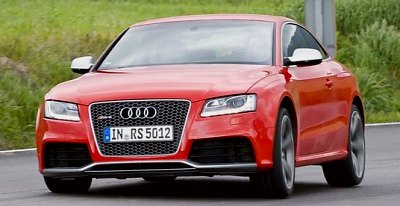
|
Quattro GmbH poured all the most
sophisticated weapons in its arsenal to the RS5 without the slightest
reserve...
|
Until
now, the A5 range, even in S5 form, has been criticizing for lack of
dynamic finesse and driver interaction. In particular, its chassis
feels nose-heavy, its steering talks little and its ride rock hard.
This mean what originally supposed to be a "modern Quattro" turned out
to be a big disappointment. The ultimate version, RS5, is the last
chance to save its face. Engineered and built by Audi's performance
division Quattro GmbH, whose track records include the very successful
(last generation) RS4 and R8, as well as the fast but uninspiring RS6
and TT RS, it is not easy to predict the outcome. However, if Quattro
GmbH does its best to the car, it will definitely have a good chance to
succeed.
So it is promising to see Quattro GmbH poured all the most
sophisticated weapons in its arsenal to the RS5 without the slightest
reserve. First is a high-revving 4.2-liter FSI V8. It is a distant
relative to the one serving the last RS4, but better in every respect.
Output increased by 30 ponies to a total of 450 horsepower. Maximum
torque remains at 317 pound-foot, but now available from 4000 to 6000
rpm instead of the previous 5500 rpm. Redline is raised from 8250 rpm
to an eye-popping 8500 rpm - yes, higher revving than BMW M3 ! Reduced
internal friction, regenerative braking, on-demand water/oil pump and
7-speed double-clutch gearbox resulted in 20 percent lower fuel
consumption. Performance is predictably strong - 0-60 mph acceleration
takes 4.4 seconds. Top speed is regulated at either 155 mph or 174 mph
depending on which option box you tick, yet neither shows its real
potential.
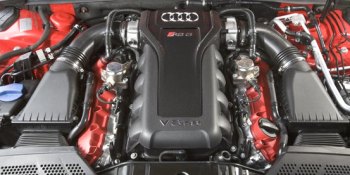
|
Power is produced linearly from 2000
rpm all the way to 8250 rpm... but the harder you work, the more reward
you get...
|
To
resist instability at speed, the RS5 has a rear spoiler deployed at
above 75 mph. Its pronounced lip spoilers, colored in aluminum, serve
to reduce aerodynamic lift as well as drawing cold air towards the
oversized cooling intakes. Visual effect is remarkably close to the TT
RS, but the RS5 is better proportioned, of course.
More sophisticated technologies can be found in the chassis. RS5
introduced a new generation Quattro system which employs a new,
crown-gear self-locking center differential instead of the usual Torsen
device. It normally distributes 40:60 torque front to rear. In case of
tire slip, up to 70 percent and 85 percent power can be directed to the
front axle and rear axle respectively. Besides, the latest ESP and
brake hardware allows torque vectoring - by soft-braking the inside
front and rear wheels in corner, understeer can be eliminated. If you
want more responsive and progressive torque vectoring, tick the option
box of Sport Differential, which really uses multi-plate clutches to
shift torque between the rear wheels.
The suspensions of RS5 sits 20 mm closer to the ground than other A5s.
Like RS4, it incorporates Dynamic Ride Control to contain its pitch and
roll due to the nose-mounted engine. DRC links the shock absorbers of
the
diagonal wheels (i.e. front right wheel to rear left wheel and front
left wheel to rear right wheel) through hydraulic. A valve controls the
fluid flow rate hence the degree of damping stiffness. This valve is
controlled by the Audi Drive Select system, whose Dynamic / Comfort /
Auto modes also alter the throttle, gearshift, steering, ESP and
torque-vectoring characteristic. More interesting, you can tailor the
individual settings of each mode if the default is not your cup of tea.
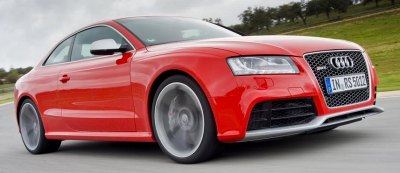 |
This is the best handling
front-engined Audi since the Ur Quattro.
|
Fast cars should have great stoppers. The RS5 is no exception. Its
front brakes employ monster 365mm dual-cast discs and 8-piston
calipers, which
compare with M3's brakes like Big Mac versus regular hamburger. If not
enough, you can pay premium for ceramic brakes.
But I don't think the ceramic brakes strictly necessary on the road. If
you take them, together with the must-have sport differential, DRC and
sports bucket seats, you will end up at 20-25 percent premium over BMW
M3. Even without the super-expensive stoppers, the RS5 is still at
least 10 percent more expensive than its rival.
On the
Road
The 4.2-liter V8 is a masterpiece - actually the best part of the car.
It is so smooth and free-revving. Power is produced linearly
from 2000 rpm all the way to 8250 rpm. There is plenty of tractability
at the
bottom end, though it is not as manic as AMG's 6.3 V8. However, its
strength starts from 4000 rpm, so you are always tempted to
access the upper half of its power band. The addictive high-pitch
exhaust
roar also encourages you to do so. The harder you work, the more reward
you get from the sound and power. Such an inspiring experience is rare
to Audi.
The 7-speed S-Tronic gearbox is predictably smooth and responsive. The
only complaint is its shift paddles, which are fixed to the steering
wheel rather than steering column. Swivel the steering wheel in hairpin
and you may forget which paddle operates downshift. The German always
tries to differentiate from Ferrari for the sake of differentiation.
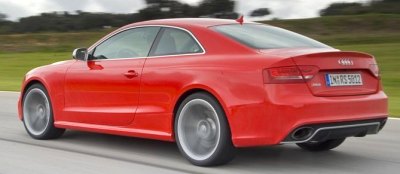 |
There is a layer of coldness between
you and the car...
|
The
chassis dynamics is very good indeed. Predictably, the sophisticated
Quattro drivetrain and massive rubbers generate tremendous grip and
traction, resulting in excellent all-weather handling. Now the torque
vectoring also tamed its inherent understeer, which is even less than
the last RS4. With the control system set at Dynamic mode, the RS5
flows in the twisty with remarkable agility. You can carry huge speed
into corner, relying on the powerful brakes to shed speed, the huge
grip and torque vectoring to overcome the corner. This is the best
handling front-engined Audi since the Ur Quattro.
However, dynamic mode does bring some harshness to ride quality if you
are driving on less than smooth surfaces, even though it is more
bearable than the stiff-legged S5. Switch to Comfort mode, the ride
becomes more forgiving, but body control deteriorates significantly.
The best compromise is Auto mode, which switches between hard and soft
suspension setting automatically, and works quite brilliantly in the
real world. It's no Lotus Evora, of course, but ride quality is no
longer the Achilles' heel of this Audi.
What remains its weakness is communication, or the lack of it. No
matter how strong its handling and performance is, it does not engage
the soul of its driver through the heavy but numb steering, the
artificial elimination of body roll, pitch and understeer. You get
understand its cornering limit through trial and error rather than the
signals it deliver. You have to believe in its competence with your
brain, rather than feel its competence with your senses. This leaves a
layer of coldness between you and the car, and prevent the RS5 from
matching the mighty Quattro. The only area that gel with you is the
powertrain, so there is a strange disharmony between the powertrain and
chassis.
Thanks to its superb drivetrain and all-weather performance, the RS5 is
an excellent cross-country express, especially now with its new found
agility and composure. However, as an ultimate driver's car, it cannot
beat BMW M3 and Mercedes C63. Both are sharper, more honest and more
characterful than the Audi, and therefore more satisfying to drive hard.
|
Verdict:     |
Published
on 12
Oct 2010
|
All rights reserved.
|
|
S5 Sportback
|
|
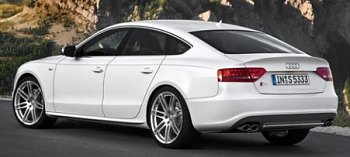 An
S5 is
essentially an A5 coupe enhanced with V8 power, so naturally, S5
Sportback should be the 5-door hatchback version of S5, shouldn't it ?
Sorry, these days things don't happen so straightforward at Audi. The
Ingolstadt guys thought that a V8 is probably too frenetic to the
5-door and decided to give it a more rational 3-liter supercharged V6.
Yes, the same unit of S4 sedan. It gives away 20 horsepower at 7000 rpm
but compensates with stronger torque across the whole spectrum.
Needless to say, fuel economy is vastly improved from the V8, while
performance loss is non-existent. So why does the S5 Sportback
take more than 5 seconds to go from rest to 60 mph despite of its
standard Quattro and 7-speed twin-clutch gearbox ? The only explanation
must be weight, some 1.75 ton of it. It makes the car slower than
either S4 and S5, and robs it of a breathtaking driving experience. Its
acceleration is linear and refined rather than thrilling. Ditto the
exhaust note, which can't match the V8. An
S5 is
essentially an A5 coupe enhanced with V8 power, so naturally, S5
Sportback should be the 5-door hatchback version of S5, shouldn't it ?
Sorry, these days things don't happen so straightforward at Audi. The
Ingolstadt guys thought that a V8 is probably too frenetic to the
5-door and decided to give it a more rational 3-liter supercharged V6.
Yes, the same unit of S4 sedan. It gives away 20 horsepower at 7000 rpm
but compensates with stronger torque across the whole spectrum.
Needless to say, fuel economy is vastly improved from the V8, while
performance loss is non-existent. So why does the S5 Sportback
take more than 5 seconds to go from rest to 60 mph despite of its
standard Quattro and 7-speed twin-clutch gearbox ? The only explanation
must be weight, some 1.75 ton of it. It makes the car slower than
either S4 and S5, and robs it of a breathtaking driving experience. Its
acceleration is linear and refined rather than thrilling. Ditto the
exhaust note, which can't match the V8.
In fact, you can tell a similar story for its handling and ride. The S5
Sportback is undeniably competent – lots of traction and safe handling
from the 4-wheel-drive system, easy control thanks to the S-Tronic
gearbox and well-calculated compromise between body control and ride
quality. However, it is just not very fun to drive. Even if you tick
the optional active differential and active steering, it still lacks
the incisive response and feel of M3 or C63 AMG. Like most other fast
Audis, you can feel it employs a lot of technologies to mask its flaws,
but also filters away all feedback in the process.
Fortunately, this car still has a mass-destruction weapon – Style. It's
beautiful enough to lure buyers from S4, even though it asks for 10%
more money. To me, S4 is more sensible to buy, whereas BMW 335i is
still the class leader. |
Verdict:     |
| Published
on 21
Oct 2011 |
All rights reserved.
|
|
S5 3.0TFSI
|
|
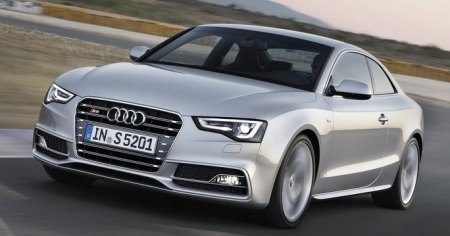
The trend for downsized
turbocharged motors is unstoppable. We have seen Volkswagen replacing
R32 with the four-cylinder turbo Golf R, Hyundai ditching
V6 in its Sonata and BMW substituting its traditional straight-six with
turbocharged four. Now Audi is also abandoning its 4.2-liter V8 in the
S5. Taking its space is inevitably the 3.0 TFSI supercharged V6, which
is already serving S4 and S5 Sportback. The transplant reduces CO2
emission dramatically from 283 to 190 grams per kilometer, or a saving
of 33 percent !
Admittedly, not all that savings come from the reduction of cylinders.
Part of it is contributed by the 7-speed S-Tronic twin-clutch gearbox,
which is introduced to the S5 coupe for the first time. In the default
automatic mode it employs lazier, fuel-saving shift patterns. Other
contributing factors include the automatic engine stop-start and the
new
electromechanical power steering – both are now standard on the whole
facelifted A5 range as means to enhance efficiency.
Talking about facelift, the S5 enjoys a style developed further from
the new A6, in particular the angular headlights (with integral LED
daytime running lights) and a trapezoidal grille. It is more elegant
than before, but the S5 is still far from the most beautiful coupe that
Walter de Silva wanted us to believe. Other improvements come together
with the facelift are new Quattro system with crown-gear self-locking
center differential, brake-actuated torque vectoring, optional sport
(active rear) differential and Audi's Drive Select control system – all
are benefited from the flagship RS5. The MMI and infotainment system
have been improved, too.
What about the supercharged V6? At 333 hp, it produces 21 horses less
than the outgoing V8, but its peak torque equals to the latter, and the
torque curve is flatter (although the V8 was hardly peaky). This wider
power band, together with the upgrade to 7-speed S-Tronic box, allows
Audi to claim a 0.2 sec reduction to 0-60 mph, resulting in only 4.7
seconds. It is slightly quicker than BMW 335i Coupe, more so than
Mercedes C350 Coupe, but not up to the level of M3 and C63 Coupe.
Price-wise, the S5 is also sandwiched between the two groups, so I
would say its performance is reasonable.
In our last report of BMW Z4 sDrive28i, we were not convinced by the
switch from six to four cylinders. But going from eight to six
cylinders is another matter. The Audi supercharged V6 is as smooth as
the outgoing V8. It also sings very well, if not as characterful as the
V8. Moreover, on the road you can feel the wider power band brings
better response, so the quicker acceleration figure is believable.
In terms of driving thrills, the revised S5 is still a bit cold compare
with some really great driving machines. Its electromechanical
steering, though responsive and well weighted, is not totally
transparent. The combination of new Quattro system and sport
differential might have reduced understeer in corners, but still you
can feel the weight it carries up front and the electronic trickeries
working busily to correct things. Equally busy is the ride over bumpy
roads, especially if you engage Dynamic mode. What you can't deny is
its ease of
driving. With abundance of traction, torque and countless of electronic
driving aids, the S5 can cover ground quickly yet effortlessly.
Compare with RS5, the S5 offers 90 percent of its talent at 75 percent
price. That seems to be a bargain. However, the best of the family is
perhaps the Sportback version of S5, which has received the same
facelift. It
offers proper rear accommodation and a prettier look. Both cars are not
perfect, but they should enjoy plenty of survival space as 3-series
coupe is getting old and C-class coupe is underachieved.
|
Verdict:     |
|